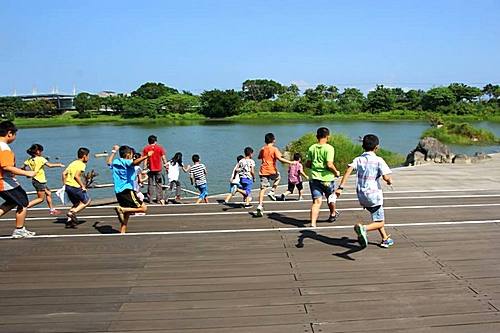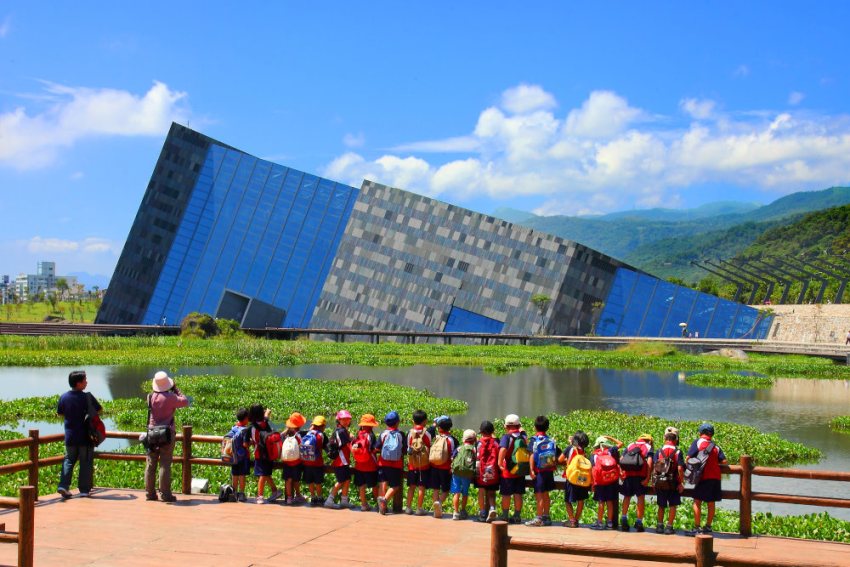Situated on the former site of Toucheng’s Wushi Harbor, which was Yilan’s main port during the Qing Dynasty, Lanyang Museum faces Guishan Island, a local landmark. Nearby stones are representative of Yilan’s history, culture, and natural surroundings.
The wetlands on the museum grounds were referred to as the amazing sight—the masts of sailing ships during the Qing Dynasty. In 1878, a typhoon swept sediment into the harbor, adversely impacting shipping. The river channel eventually shifted to what is today known as Touwei Harbor and Wushi Harbor gradually turned into wetlands. Renovation on buildings began in 1990 and the harbor was repositioned into a tourist destination. Today, it is the base for whale-watching excursions and trips to Guishan Island. In 2006, it was registered as a “cultural landscape” in accordance with the Cultural Heritage Preservation Act.
Although Wushi no longer functions as a port, the Wushi Wetlands continue to be very important as they boast abundant water and they affect the climate, serve to collect water and prevent flooding. They also encompass ecological resources that serve as habitats for various plants and animals. The exterior of Lanyang Museum’s main structure was designed to resemble the cuestas, local geographical formations that are prevalent along Taiwan’s northeast coast. In an effort to “coexist with the environment and blend with nature”, designers opted for a building configuration that was medium in size, so as not to break up the integrity of the wetlands.

We promote the idea that “Yilan is a museum” and Lanyang Museum is a “window” through which visitors can get to know the area. By safeguarding and maintaining the natural and cultural environments, members of the Yilan family of museums have been working together to integrate local resources as they promote the sustained development of the area’s ecology, culture, and environment. To that end, they have designed environmental education courses to create venues where people can “learn happily, enjoy leisure, and be taught about the local culture and environment”. In September of 2013, the Lanyang Museum and the wetlands received “The Certificate Environmental Education Facility and Field” for promoting environmental education from the Environmental Protection Administration under the Executive Yuan. In 2017, it was honored with First Prize at the Fifth Annual National Environmental Education Awards.
Yilan County is unique in terms of geography, history, and culture and has developed its own culture of knowledge, including six important areas of cultural significance: “developing Lanyang”, “lives of the people”, “water and green resources”, “marine fishery”, “agricultural and logging industries”, and “local flavor”. Lanyang Museum has designed environmental education courses based on these objectives and taught both in classrooms and outdoor educational venues. Courses are designed around the field resource system’s wetland ecology, cultural landscape, geographical landscape, whale and dolphin conservation, prehistoric culture, and the environment of Yilan, so students can learn about the area’s diverse cultures and environments and how they have changed over time and from place to place. The courses were designed with five major objectives of environmental education in mind, so that they can be used as supplementary course materials in the Grades 1-9 Curriculum.
Course implementation took into consideration the various needs and planning of all concerned and includes “Come to Lanyang Museum and have fun while learning about the environment”, a course which is available in the museum itself, and “The museum comes to campus”, which is offered in schools, as well as hands-on learning activities that are held outdoors. The promotion of these courses helps to protect Lanyang’s precious land and environment.



